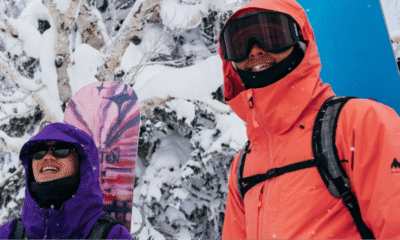Published August 6, 2025 03:00AM
Destinations & Things To Do
Gen Z Just Figured Out What Boomers Already Knew—Cottage Cheese Slaps

If you buy through our links, we may earn an affiliate commission. This supports our mission to get more people active and outside.Learn about Outside Online’s affiliate link policy
The white, clumpy curd was all the rage in the early 20th century, but it has recently made a comeback. Young people are putting it in everything from dips and pastries to ice cream. While once pushed as a meat alternative during the First World War, its current craze seems to be rooted in Zoomers’ quest to achieve #fitlife. So, what makes cottage cheese the protein-packed star of the moment?
(Photo: Left: Canadian-American actress Ann Rutherford (1917 – 2012) prepares herself a pineapple and cottage cheese salad sprinkled with paprika, circa 1939, Archive Photos/Getty Images; Right: Cottage cheeses: Trader Joe’s, Daisy Brand, Good Culture; Design: Ayana Underwood)
I have a confession: in the middle of my 75 Hard spiral—a social media-sanctioned self-optimization grind disguised as a fitness challenge—I made queso. Not just any queso. Cottage cheese queso. This is a sentence I never thought I’d write.
I started the challenge this past February—partly to beat the winter blues in the Northeast, and partly because I needed a reset after taste-testing one too many of Santa’s cookies. I was committed to said challenge. This meant: doing two 45-minute workouts (at least one of them outdoors), reading ten pages of a nonfiction book, and drinking a gallon of water . . . each day. Most intimidatingly, I was supposed to stick to a diet of my choosing. I went all in: HIIT training, 4.5-mile runs, Becoming Supernatural queued up on my e-reader, and a squeaky-clean keto plan that had me eating organic, grass-fed (and grass-finished) beef that I could barely afford. I tracked macros and considered electrolyte ratios. I had come to terms with the fact that I’d become someone who used the term “electrolyte ratios” in casual conversation.
And then I burned out.
Somewhere around Day 42, I traded mountain climbers for Yin Yoga. I prioritized taking long walks, watching white-tailed rabbits hopping alongside the estuary near my home in Boston, Massachusetts, over chasing yesterday’s personal best. The diet? That crumbled when I tried to justify the cost of avocados and eggs and failed. (Within the last year, the price of a single avocado rose by 75 percent, and the usual three bucks I’d spend on a carton of eggs turned into five.)
Still, I wanted to eat well(ish), which for me, means protein-heavy, low-effort, and ideally not financially ruinous. So, like any overstimulated elder millennial trying to avoid decision fatigue (and wear sunscreen, and hydrate, and remember to call mom), I turned to Instagram.
Welcome @KetoSnackz to the chat. With 3.5 million followers, Rick Wiggins shares quick, high-protein recipes meant to satisfy cravings while staying protein-powered. His creations looked suspiciously easy. His voice was refreshingly monotone. I was in.
As I scrolled, one ingredient kept popping up, an ingredient I found personally affronting: cottage cheese. It was white and lumpy. It was wet. It was everywhere. Rick blended it into pizza crusts, brownies, and pancakes. And it wasn’t just on Rick’s page. TikTok, too, had fully surrendered to the curd—which was confusing. Because for me, I never saw it in my Caribbean household growing up. My parents didn’t eat it. We didn’t cook with it. To borrow from Mariah Carey: I don’t know her.
So when I made queso out of it (blended with cheddar, cream, taco seasoning, and hot sauce) and served it to a friend while hanging out, I didn’t tell them what was in it. They liked it. Called it “fire.” Then I broke the news.
They looked at me like I’d confessed to putting mayonnaise in brownies: “Wait . . . like, real cottage cheese?”
“Yes. From a tub. Bought on purpose.”
I was surprised, too, because the queso was, in fact, fire. But I was also curious. Because how did goat cheese’s sad, curdled step-cousin become America’s newest protein-packed heartthrob?
I. TikTok, but Make It Clumpy
In April 2023, holistic nutritionist Lainie Kates—@lainiecooks on TikTok and one of the creators credited for the renewed interest in cottage cheese—posted a high-protein peanut butter cheesecake “ice cream” recipe. In it, she blended cottage cheese, peanut butter, chocolate chips, and maple syrup. Froze it. Ate it. Her video went viral. The internet was flooded with cheesecake bowls, ranch dips, and “protein donuts”—most of which starred cottage cheese. It didn’t matter that the texture was off-putting. It blended well. It hit macros. That was enough.
Then brands caught on. In 2024, Daisy, sour cream’s shepherd, partnered with The Bachelor’s Daisy Kent to promote the brand’s equally famous cottage cheese.
Just this month, Trader Joe’s dropped Ranch Cottage Cheese Dip. Good Culture, a brand started in 2015, was literally born out of the desire to bring a revamped, better-tasting, and healthier version of cottage cheese to the public. A few weeks ago, they put out a meme-laden statement on Instagram saying that they can’t keep up with the demand for their iconic cottage cheese, confirming the cheese’s renewed popularity.
The message? This is food you eat because it’s good for you—crafted with “good-for-you-ingredients,” made with only “the good stuff,” and “a versatile bit of dairy capable of providing protein and texture.” That’s how the brands framed it. And if the messaging sounds familiar, that’s because we’ve heard it before.
II. A Short History of a Long Shelf Life
In the early 1900s, the U.S. had a problem: meat was scarce during World War I. To help conserve it, the U.S. Department of Agriculture promoted dairy as a substitute. Posters encouraged people to “Eat More Cottage Cheese.” It wasn’t just a suggestion; it was patriotism.
By the 1950s, cottage cheese had migrated from the war effort to weight-loss plans. It was low in fat, high in protein, and flavorless enough to avoid overindulgence. You could measure it. You (probably) wouldn’t overeat it. Thus, it was ideal for calorie counting.
That’s right around the time when the “diet plate” made its way to America’s diner menus—usually a scoop of cottage cheese, a ring of canned peach or sliced tomato, maybe a wedge of iceberg lettuce. It wasn’t really a meal. It was more of a performance. A way to show you were being good. These plates lingered well into the seventies and eighties, eventually evolving into the “Lite” menu I remember seeing at Long Island diners during my childhood in the nineties. Same scoop, same canned fruit—just rebranded for the next generation of restraint.
By 1972, Americans were eating about five pounds of cottage cheese per person each year. Even Richard Nixon was known to pair his with ketchup. YUM. He had such a lust for lactose, in fact, that he reportedly requested cottage cheese at his 1969 inauguration dinner. And when he resigned from office in 1974? His final White House lunch was cottage cheese with pineapple and a glass of milk. A presidency bookended by curds.
III. Who Was It Really For?
Not everyone was eating it. Rather, not everyone was meant to be eating it. Mid-twentieth-century food campaigns primarily targeted white, middle-class women. Cottage cheese came with a message—eat this, stay thin, stay beautiful, stay in control.
Cottage cheese was sold as a democratic food: cheap, accessible, healthy. But it never belonged to everyone.
Even when it showed up in government campaigns and school lunches, it wasn’t a staple in every home. It simply didn’t catch on in many immigrant, Black, and working-class communities. Part of that was logistics. Cottage cheese requires refrigeration, fresh milk, and a cold distribution chain, not always available in rural or low-income areas.
Look at the ads. White women in full makeup, smiling at tubs of cottage cheese like they’d just invented it. One Eden Vale ad shows a nuclear family floating through a suburban utopia, landing at a table set with cottage cheese salads and a big tomato. A Knudsen ad features a flawless woman offering a tub of “VELVET creamed cottage cheese,” promising sweetness, lightness, and domestic perfection. Borden’s went all in: cartoon cows, crisp lettuce, and cottage cheese rings studded with peas and carrot sticks. No spice, no mess—just a carefully styled portrait of control, domestic order, and cultural exclusion.
These images weren’t neutral. They reinforced the message: this is who eats this, and this is how you serve it. In her 2011 book, Food Is Love: Food Advertising and Gender Roles in Modern America, historian Katherine J. Parkin argues that mid-20th-century food advertising reinforced narrow ideals of femininity, pressuring women to equate thinness, domestic perfection, and family nourishment with personal value. The goal of these ads?
But the bigger issue was taste. Cottage cheese didn’t reflect the ingredients or textures of most non-white food cultures.
My Caribbean family’s fridge, for example, held sorrel, pepper sauce, and mango chutney, not clumps of dairy. So, when I brought home a container of Good Culture to recreate my (self-proclaimed) famous queso, they looked at it suspiciously. Then they asked what I planned to do with it. When I said “queso,” they raised their eyebrows and sucked their teeth. They weren’t offended. Just confused. It’s understandable because the marketing never spoke to them. And it wasn’t designed to.
IV. Cottage Cheese Loses Its Steam
Even among the people it was supposedly for, cottage cheese couldn’t hold on.
By the 1980s, its popularity started to slide—quietly edged out by a new dairy star with smoother texture, stronger marketing, and fewer identity issues: yogurt. High in protein, rich in backstory, and aggressively rebranded as a probiotic superfood, yogurt didn’t just enter the chat—it took over the conversation.
Cottage cheese didn’t know how to compete. There were no new formats, no updated flavors, no attempt to win over younger shoppers. It stayed in its big old tub, parked on the fridge shelf. Meanwhile, yogurt was out living its best life—popping up as Go-Gurt in school lunchboxes, and with glass jars with foil lids in meal-preps. One became a lifestyle product; the other stayed a buffet-line staple at your grandmother’s favorite salad bar.
The texture didn’t help. In a 2012 study published in the Journal of Dairy Science, researchers found that texture was the biggest barrier to cottage cheese acceptance, especially among younger consumers. The graininess, visual lumpiness, and curdy mouthfeel turned people off, even when the fat and protein content hit all the right numbers. Even versions labeled “low-fat” or “high-protein” couldn’t overcome the basic sensory mismatch. People didn’t hate what it stood for. They just didn’t want to eat it and feel it on their tongues.
At the same time, yogurt brands were investing in stories. Chobani was founded by an immigrant entrepreneur who turned a struggling factory into a billion-dollar company. Dannon built a whole campaign around Georgian centenarians and the secret to long life. Yogurt had a point of view. Cottage cheese didn’t even have a spokesperson.
By the 2010s, yogurt was outselling cottage cheese nearly eight to one. And cottage cheese wasn’t just fading in market share—it was fading in memory. It stopped being an expectation. For most people, it stopped being an option.
So when it started trending again—sneaking into dips, desserts, and TikTok reels—it felt less like a comeback and more like a glitch. Cottage cheese didn’t evolve. It was just repurposed. And maybe that’s the clearest sign of its legacy: it survives not by being loved but by being useful.
V. Diet Culture, Rebranded
Today’s cottage cheese wave still centers on the same values: control, efficiency, and self-regulation. The language changed, but the pressure stayed. It’s no longer “stay thin for your husband,” it’s “optimize your macros.”
The look changed, too. It’s not a scoop on a peach slice. It’s whipped, blended, hidden in dips, ice creams, and sauces. It’s in a glass bowl, drizzled with chili crisp and tagged #highprotein on an influencer’s “What I Eat in a Day” reel. But the performance is the same: eat this to prove you’re doing the work.
We used to count calories (some people still do). Now we count macros. We used to tally Weight Watchers points. Now we use apps and fitness watches to track calories burned. We used to aim for thin. Now we say lean.
Blending until smooth is a requirement. The texture is still a problem, it’s just one we’re now expected to fix. And the brands know that.
Modern cottage cheese branding sells function first: gut health, low carb, high protein. The packaging often mirrors wellness trends—clean lines, block fonts, neutral palettes—the same aesthetic you’d find in a Scandinavian furniture showroom. Some lean into compliance culture, highlighting Whole30- or keto-friendly ingredients. Others soften the message by adding flavor cues, but even then, pleasure is usually positioned as a bonus, not the point.
Take Trader Joe’s ranch cottage cheese dip: “a fantastically flavorful dip,” yes—but only after mentioning its protein content, versatility, and use in pancakes, pasta, and frittatas. The indulgence comes with an asterisk. It’s not just tasty—it’s functional.
I’ve tried the Good Culture stuff. It’s fine. It blends well. But cottage cheese itself still needed a rebrand—not because it was forgotten, but because it was never truly loved. It has to justify itself because it can’t rely on flavor or nostalgia.
Maybe that’s why it fits so well into modern wellness culture. We’ve replaced calorie charts with meal-prep hacks. But the goal remains: Build a better body. Be a better person. Stay in control.
Cottage cheese still fits that mold. Just like it always has.
VI. Reflection: The Cheese That Refused to Quit
I didn’t expect to end up here—with a half-used container of cottage cheese in my fridge and a short list of recipes I’m not embarrassed to share. I still don’t love it. I don’t crave it. But I’ve learned to respect it.
That respect came from looking back. Cottage cheese didn’t trend because a TikToker froze it into a dessert. It’s been around for over a century, always showing up when we decide food should prove something. War, weight loss, wellness—cottage cheese shows up to work. (FYI: I explain some even more extraordinary uses for cottage cheese in the video below.)
Once it was about thrift. Then self-denial. Now it’s optimization. But the message doesn’t change: If you eat this, you’re trying. You’re disciplined. You’re doing it right.
And that’s why it still makes people uncomfortable.
You don’t have to explain why you like donuts. But cottage cheese? You need a reason. High protein. Gut-friendly. You don’t just eat it, you earn it.
Whether I’ve earned it or not, I’ve blended it into queso. Stirred it into pancakes. Eaten it—very reluctantly—by the spoonful. Once. I’m not a fan.
But I’m not against it anymore, either.
Marisa McMillan is a first-generation Caribbean-American writer, podcast host, and relationship management professional with a passion for storytelling, social justice, and asking the questions that often go unspoken. With a background in eCommerce strategy, client partnerships, and digital communication, she brings curiosity, humor, and heart to every conversation. She hosts a podcast that explores women’s health through honest dialogue, generational storytelling, and the kinds of questions rarely asked out loud. Rooted in a love of nature, movement, and meaningful connection, Marisa sees storytelling as a bridge—elevating overlooked narratives and creating space for empathy, growth, and impact. She holds a B.A. in English and Political Science from Boston University.
Destinations & Things To Do
Florida, California, New York and Other Rising Destinations in the US vs UK’s Top Destinations London, Edinburgh, Liverpool and More: Here is a Groundbreaking 2025 Travel Comparison of Two Powerhouses

Published on
August 7, 2025 |
By: TTW News Desk
As we move through 2025, both the United States and the United Kingdom are seeing remarkable travel booms, with tourists flocking to iconic destinations across these two powerhouse nations. From the sunny beaches of Florida and the vibrant streets of New York to the historic charm of London and the cultural richness of Edinburgh, both countries are experiencing surges in tourism. This comprehensive comparison explores how rising destinations in the US like California and Florida are drawing millions of visitors, while the UK’s top cities like London, Liverpool, and Edinburgh continue to attract travelers with their rich history, cultural experiences, and new developments. By examining the major attractions, growth patterns, and key drivers behind this travel boom, we can better understand how these global tourism leaders are shaping the future of travel in 2025.
US Travel Boom in 2025
Major Destinations in the US
Florida: Florida continues to reign as the most visited state in the US, attracting millions of tourists to its vibrant cities and picturesque coastlines. Orlando alone is expected to welcome 75 million visitors in 2025, marking a 5% increase from the previous year. Visitors flock to the state’s top attractions, including Walt Disney World, Universal Studios, Miami’s famous beaches, Everglades National Park, and the historic sites of Key West.
California: Despite a slight expected dip in visitation, California remains a top destination for travelers. Cities like San Francisco, Los Angeles, and San Diego continue to pull in millions of visitors annually. Major attractions such as Hollywood, Yosemite National Park, the Golden Gate Bridge, Disneyland, Napa Valley wineries, and the scenic coastal areas of Malibu offer diverse experiences for every type of traveler.
New York: New York City remains a major magnet for both international and domestic tourists. With over 65 million visitors projected for 2025, the city is seeing a 10% growth from the previous year. Times Square, Central Park, the Statue of Liberty, Broadway shows, and world-renowned museums like The Met and MoMA remain central to the city’s broad appeal and diverse cultural offerings.
Las Vegas: Las Vegas is bouncing back in 2025, with a 12% growth in tourist arrivals. Known for its extravagant entertainment, gaming options, and luxury hotels, the city continues to be a top destination for thrill-seekers and high-rollers alike. With its bustling nightlife, world-class shows, and vibrant atmosphere, Las Vegas is a must-visit for those seeking a truly dynamic experience.
New Orleans: New Orleans, known for its rich cultural heritage, is a year-round attraction for travelers. Its vibrant music scene, historic French Quarter, and renowned festivals like Mardi Gras make it a unique and lively destination. In 2025, New Orleans is expected to see steady growth in tourism, with visitors drawn to its unique blend of history, art, food, and music.
Phoenix: Phoenix continues to gain popularity, especially during spring training baseball season and for outdoor adventures in the surrounding desert landscapes. The city’s warm weather, golf courses, and luxury resorts make it a prime location for those seeking relaxation or adventure. Visitors enjoy hiking in the nearby desert, exploring the nearby Grand Canyon, and taking in the city’s growing cultural scene.
US Air Travel Stats in 2025
Airline Growth in the US: US airlines are experiencing a 7% increase in passenger traffic in 2025, compared to 2024. Major carriers such as American Airlines, Delta, and Southwest are expanding both domestic and international routes, making travel more accessible to a broader audience. This surge in air travel is a direct reflection of the growing demand for leisure and business trips.
Growth Drivers: The growth of the airline industry is fueled by several factors. Pent-up demand from previous years, the expansion of flight routes, and a strong economic recovery are key contributors. Additionally, social media’s influence on travel trends has inspired many to explore new destinations, further boosting airline traffic.
US Hotel and Destination Stats
Hotel Growth: Hotel bookings in key US cities are experiencing a 10% year-on-year increase, with high demand in popular destinations like New York, Miami, and Orlando. These cities are seeing record-high occupancy rates as more travelers flock to experience their iconic attractions. The surge in bookings is a positive indicator of the continued growth and recovery of the US hospitality sector.
Cost: Inflation has led to rising costs for domestic flights and hotel stays, prompting some travelers to seek more budget-friendly options or shorter trips. The increase in prices has created a shift in travel preferences, with many opting for destinations closer to home to manage expenses.
UK Travel Boom in 2025
Major Destinations in the UK
London: London remains the top destination for international tourism in the UK, with an estimated 20 million visitors expected in 2025, marking a 15% increase from 2024. Iconic attractions such as the Tower of London, Buckingham Palace, the British Museum, and the London Eye continue to draw crowds. New developments, including the expansion of the Museum of London and the Tottenham Hotspur Stadium, are adding to the city’s appeal, ensuring it remains a global cultural and historical hub.
Edinburgh: Edinburgh, the Scottish capital, is experiencing a tourism boost, particularly during the summer months, with an expected 3.5 million visitors in 2025. Visitors are drawn to the city’s rich heritage, including Edinburgh Castle, the Royal Mile, and Arthur’s Seat, offering a mix of history, culture, and natural beauty. The annual Edinburgh Fringe Festival also attracts thousands, contributing to Edinburgh’s status as a must-visit cultural destination in the UK.
Manchester: Known for its vibrant cultural scene and music heritage, Manchester continues to grow in popularity, with a 10% increase in visitor numbers in 2025. The city offers a unique blend of modern and historical attractions, including the National Football Museum, Manchester Art Gallery, and the lively Northern Quarter. As a hub for sports and music, Manchester is a dynamic destination that draws both domestic and international tourists looking for diverse experiences.
Liverpool: Liverpool, home to the legendary Beatles, is expected to attract 4 million tourists in 2025, a 9% increase over the previous year. Visitors flock to iconic attractions like The Beatles Story, Albert Dock, and Anfield Stadium. The city’s rich musical history and maritime heritage, combined with its vibrant cultural scene, make it a top destination for both music lovers and history enthusiasts alike.
Bristol: Bristol is seeing a rise in international tourism, driven by new cultural and artistic events that are transforming the city’s appeal. Key attractions include the Clifton Suspension Bridge, Bristol Zoo, and the popular Street Art Tour, featuring works by Banksy. With its mix of modern creativity and historical landmarks, Bristol is becoming an increasingly sought-after destination for those looking to experience a blend of art, history, and culture in the UK.
UK Air Travel Stats in 2025
Airline Growth in the UK: UK airports are experiencing an 8% increase in air passenger traffic in 2025 compared to 2024. Heathrow and Gatwick are leading the way, benefiting from expanded international routes, particularly from North America and Europe. This growth is indicative of the UK’s strong tourism recovery, driven by the return of international travelers.
Growth Drivers: Several key factors contribute to the UK’s air travel boom. The recovery from the pandemic, easing of travel restrictions, and major cultural and sporting events, such as the Edinburgh Fringe Festival and Premier League football matches, are all fueling the rise in international visitors and boosting overall tourism.
UK Hotel and Destination Stats
Hotel Growth: Hotel bookings in major UK cities like London, Edinburgh, and Manchester have seen a 12% increase, with boutique hotels and luxury accommodations seeing a notable rise in popularity. As tourism continues to thrive, travelers are opting for more personalized stays, contributing to the expansion of these premium options across urban centers.
Cost: The growing demand for travel, coupled with inflation, has driven up hotel and travel prices in the UK. While popular destinations see price hikes, lesser-known regions like Wales and Northern Ireland are promoting affordable alternatives, providing budget-friendly options for travelers seeking unique experiences.
Comparative Overview: US vs UK Travel Boom in 2025
| Category | United States | United Kingdom |
|---|---|---|
| Major Destinations | Florida, California, New York, National Parks | London, Edinburgh, Manchester, Liverpool |
| Visitor Numbers | 77.1 million international arrivals projected | 41.2 million international arrivals projected |
| Air Travel Growth | 15% increase in international arrivals compared to 2024 | 8% increase in international arrivals compared to 2024 |
| Tourism Spending | Over $200 billion in international visitor spending | £33.7 billion projected in 2025 |
| Key Attractions | Disney World, Grand Canyon, Statue of Liberty | Buckingham Palace, Edinburgh Castle, British Museum |
| Eco-Tourism | Yellowstone, Yosemite | Lake District, Scottish Highlands |
| Sport Tourism | Super Bowl, NBA Finals | Premier League, Wimbledon |
| Visa Policies | Stricter regulations impacting international visitors | Introduction of ETAs for non-visa nationals |
| Challenges | Decline in international tourism, geopolitical tensions | Inflation, strong currency, VAT-free shopping changes |
Comparing Travel Growth in the US and the UK
Both the US and the UK are witnessing impressive travel booms in 2025, driven by strong domestic and international demand. The US sees significant growth in popular destinations like Florida, California, and New York, with increased air travel and hotel bookings, despite rising costs. Meanwhile, the UK is seeing similar growth, particularly in London, Edinburgh, and Manchester, with robust cultural and sporting events boosting international tourism.
While both countries are thriving, the US is leading in terms of overall domestic travel spending, while the UK’s tourism boom is more reliant on international visitors. Both regions face challenges such as rising costs and airport congestion, but they remain top travel destinations globally for 2025.
Destinations & Things To Do
Colorado Trail: The Hype Is Real
I began the Colorado Trail at the Waterton Canyon Trailhead, the Denver end of the trail snake, at the beginning of August.
Embarking on this popular thru-hike has caused people to come out of the wood work, with excited expectations and experiences, with stories, with fears, and all of the hype. Whoever was talking to me, the message was clear: The CT is the best, hike it and it will be a blast from start to finish.
The state of Colorado seems to have the most hype around it too. I think stoke and hype are a currency of the place. I’m into the positivity, but because of all this build-up and lead-in to what everyone says is going to be the best thing to ever happen to me since my momma gave me life, I can only feel a little guilty that I’m going to ignore most of their talk.
I want to take this bull by the horns and realize it’s actually a moose, if you get my drift. I want to take on one of the most popular trails in the U.S. and go in pretty ignorant. I haven’t downloaded the FarOut package for the CT, nor do I know when I will, if ever. Instead, I got the handiest little databook (thank you Bitler!) for the bullet points, and will take the rest of the trail as it comes.
So far it’s working out pretty well…
Almost getting headbutted into the afterlife
I walked away from my Trail Angel for Life friend who dropped me off at the TH around 1pm. It was sprinkling off and on with thunder occasionally rolling in the distance. Despite the weather, the canyon was flat and busy with cyclists and fishermen, but I saw no other hikers like myself.
I did see an entire herd of Bighorn sheep, mostly females, including a full nursery of adorable kids. (Kids as in baby sheep.) They were adorable even as they jumped and scampered on ledges above, causing rocks and debris to rain down onto the dirt road. What an amazing encounter within my first two miles!
Within my first seven miles, I was out of the canyon, hiking switchbacks through thick and steep pine forest. A worried mountain biker passes me and warns of two big sheep he just saw on the trail, he tells me to be careful. I tell him thank you and walk with alert eyes and ears. I sing a song out loud to let whatever was out there know that I’m coming.
Too bad sheep don’t sing to let me know that they are coming… Out of nowhere barreling straight down upon me through the trees is a massive ram. Imagine the RAM truck symbol running you down in the flesh.
I remember all the wildlife signs in the canyon on how to handle encounters with sheep. First you are supposed to keep two bus lengths away from them. This ram was less than twenty feet away. So I went to the next suggestions on the list. I backed away in a panic almost slipping backwards off the trail. I put my hands up above my head to look big, and I yelled at it to STOP and BACK OFF.
He paused for a moment long enough for me to take in his heavy horns, strong shoulders, the yellow eyes and understand that I was at his mercy. He moved towards me again to the rim of the trail slope not ten feet from me. I moved until my pack was against a tree and I knew that I was stuck. If he came after me I was dead. I imagined my guts spilling, being snapped in half, and still I sternly held my hands up and yelled BACK OFF.
Somehow, he seemed to change his mind about headbutting me off the mountain and into the afterlife. He ran parallel to me from left to right and ran down the trail behind me. I didn’t stop to thank him. I jogged away, up the switchbacks knowing deep down how close I was to death. I picked up a large rock and carried it for almost two miles, afraid I might meet the second bachelor the biker had spoken of. I never did, but my paranoia was high.
I had crested the first mountain of the Colorado Trail and passed a memorial bench at the top, and I wondered if being murdered by a bighorn would get me a nice bench? I had dropped my defensive rock and was going downhill when I heard the ever nerve shattering sound of a rattle.
I leaped a few feet back to see that I had almost stepped on a young rattlesnake. Not only was it stretched across the trail, as they sometimes are, but it was also halfway through deep-throating a chipmunk. Despite my nerves being absolutely wrecked by this point, I felt bad for the little fella. Both little fellas, I guess. The munk was no longer of this world, but I had interrupted the snake’s meal at a very inconvenient time. I apologized but had a tough go on bushwhacking off trail to get around it. Once on the other side of it I looked back and the scared snake had spit out his food so as to take a defensive rattling coil. Geez I felt so bad, but at least, chipmunk excluded, we were all alive and rattled.
I continued to camp by 7:30pm at South Platte River, having hiked 17 miles for my first day on trail. I’d like to tell you how strong and brave I felt, but to be honest I was paranoid of everything in the forest up until reaching the river where there were plenty of other hikers. Besides the scary animals, I also saw three grouse/ pheasant/ forest chicken- things, hummingbirds, and mule deer. All of them scared the shit out of me. I can laugh now, but I desperately called to the heavens “thank you, but this is enough for the FIRST DAY, I think!” Colorado is fuckin’ wild.
Du-du-duh spaghetti…
Within the first few days I cruised right into a little group of hikers who have kept me in wonderful company. Our daily mileage runs from 17 – 20 depending on the general feeling, and they made my first hundred miles on the CT incredibly fulfilling.
Georgia Pass came and went like the gusts of wind that blew us around up there. We dunked our sunburnt bodies in cold creeks, and groaned and moaned together around evening camps.
One of our group has a funny saying, “Slow and steady gets the spaghetti.” He mumbles it while he is hiking particularly challenging terrain. It makes me laugh so hard that I can’t breathe for some reason. I bring it up to you all because that hard laughter is exactly why I hike.
I give myself permission to laugh until I cry and be goofy when I’m hiking. It comes out of me so readily when I’m “Whistles” on a trail. I love finding people who encourage that spirit in me, and trail always seems to gather those very people.
I’m grateful for my early CT trail family even as I may be pushing on ahead of them soon. I hope they continue hiking for their own enjoyment and self-discovery as I will!
The Hype Is REAL!
Colorado is awesome, but everyone already knows that. I’m seeing it for myself with as open and unbiased of a mind as I can muster. I’ll be honest with the good, the bad, and the stuff I never want my mom to know about.
After awhile and some miles!
Whistles
This website contains affiliate links, which means The Trek may receive a percentage of any product or service you purchase using the links in the articles or advertisements. The buyer pays the same price as they would otherwise, and your purchase helps to support The Trek’s ongoing goal to serve you quality backpacking advice and information. Thanks for your support!
To learn more, please visit the About This Site page.
Destinations & Things To Do
Vietnam named one of Asia’s most revisited travel destinations

According to recent booking data from the digital travel platform Agoda, Vietnam has risen to third place among the top five Asian countries with the highest rate of returning international visitors – behind only Japan and Thailand. Notably, Da Nang appears for the first time among the top ten Asian cities with the highest percentage of returning travelers.
On August 6, Agoda released its latest “Most Revisited Destinations” ranking, highlighting Da Nang as one of the most appealing cities in Asia.
Based on booking data from the first half of 2025, Vietnam now ranks third in Asia for returning international guests, surpassing Malaysia and Indonesia.
Of particular significance, Da Nang’s debut in the top ten marks a remarkable milestone, as Vietnam had no representatives in this list the previous year.
The vibrant coastal city in central Vietnam has firmly secured its place among Asia’s top destinations, underscoring the growing appeal of the S-shaped country on the region’s tourism map.
The five most revisited destinations in Vietnam during the first half of the year were Da Nang, Nha Trang, Ho Chi Minh City, Hanoi, and Phu Quoc. While the three beach paradises attract visitors with soft white sands, clear waters, and sun-soaked resorts, Ho Chi Minh City and Hanoi captivate travelers with their vibrant urban rhythm, rich cultural heritage, and colorful culinary landscapes. Together, they offer a perfect blend of relaxation and local immersion.
These destinations have a unique allure that makes one visit never enough. Many travelers return to complete unfinished journeys, relive memorable experiences, or simply embrace the familiar comfort of places that once stirred deep emotions.
Agoda data shows that many tourists revisited the same destination multiple times within just six months – clear evidence of the strong pull of locations that leave a lasting impression.
Vu Ngoc Lam, Country Director of Agoda Vietnam, stated that from the dynamic pace of its cities to the stunning beauty of its sun-drenched beaches, Vietnam offers a rich, authentic experience that keeps visitors coming back.
“Vietnam’s presence among the most revisited destinations in Asia is a positive signal reflecting the country’s diverse and increasingly compelling appeal,” Lam emphasized.
Alongside Vietnam, the ranking highlights other Asian destinations with high return visitor rates, including Bangkok (Thailand), Tokyo (Japan), Seoul (South Korea), Bali (Indonesia), Osaka (Japan), Taipei (Taiwan-China), Kuala Lumpur and Johor Bahru (Malaysia), and Hong Kong (China). Each offers a unique charm – from distinctive cuisine to vibrant cultural life – ensuring that every journey brings something new to discover.
PV
-

 Brand Stories2 weeks ago
Brand Stories2 weeks agoBloom Hotels: A Modern Vision of Hospitality Redefining Travel
-

 Brand Stories2 weeks ago
Brand Stories2 weeks agoCheQin.ai sets a new standard for hotel booking with its AI capabilities: empowering travellers to bargain, choose the best, and book with clarity.
-

 Destinations & Things To Do3 weeks ago
Destinations & Things To Do3 weeks agoUntouched Destinations: Stunning Hidden Gems You Must Visit
-

 Destinations & Things To Do2 weeks ago
Destinations & Things To Do2 weeks agoThis Hidden Beach in India Glows at Night-But Only in One Secret Season
-

 AI in Travel3 weeks ago
AI in Travel3 weeks agoAI Travel Revolution: Must-Have Guide to the Best Experience
-

 Brand Stories1 month ago
Brand Stories1 month agoVoice AI Startup ElevenLabs Plans to Add Hubs Around the World
-

 Brand Stories4 weeks ago
Brand Stories4 weeks agoHow Elon Musk’s rogue Grok chatbot became a cautionary AI tale
-

 Brand Stories2 weeks ago
Brand Stories2 weeks agoContactless Hospitality: Why Remote Management Technology Is Key to Seamless Guest Experiences
-

 Asia Travel Pulse1 month ago
Asia Travel Pulse1 month agoLooking For Adventure In Asia? Here Are 7 Epic Destinations You Need To Experience At Least Once – Zee News
-

 AI in Travel1 month ago
AI in Travel1 month ago‘Will AI take my job?’ A trip to a Beijing fortune-telling bar to see what lies ahead | China













You must be logged in to post a comment Login